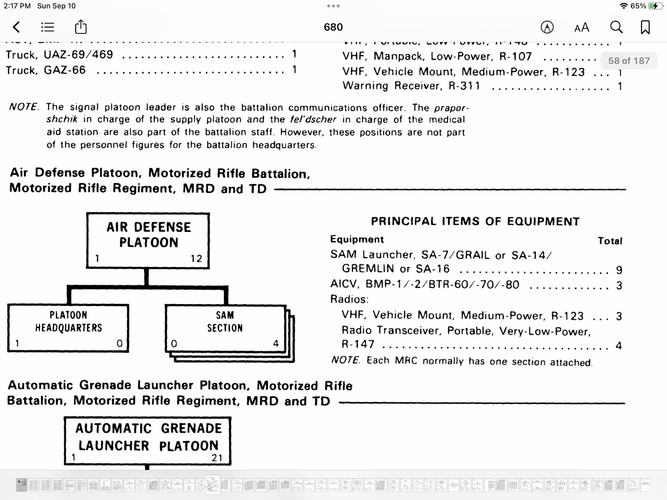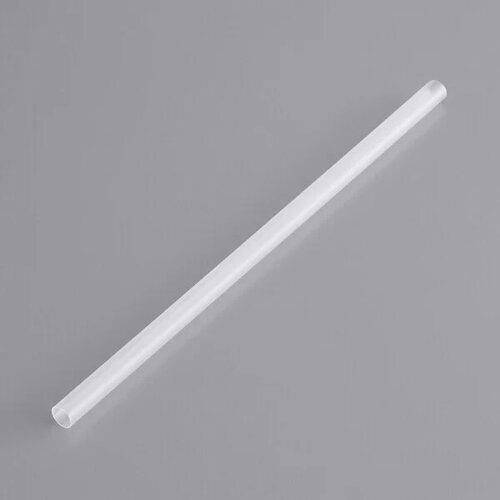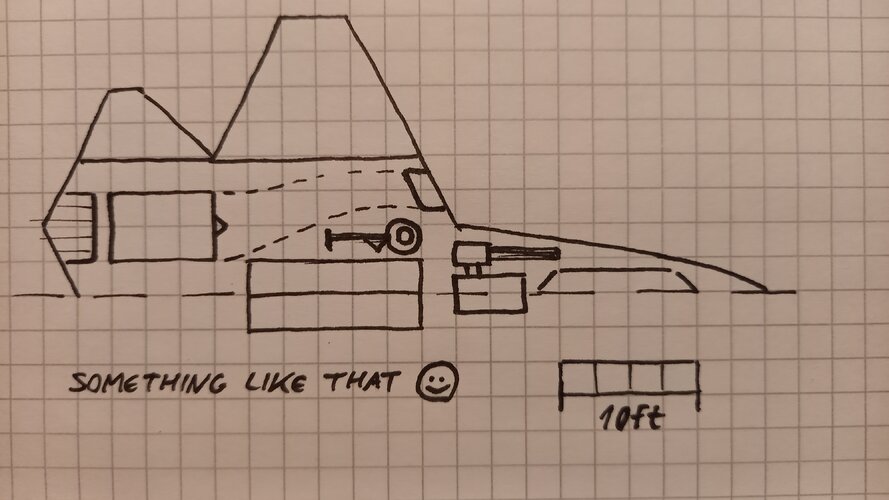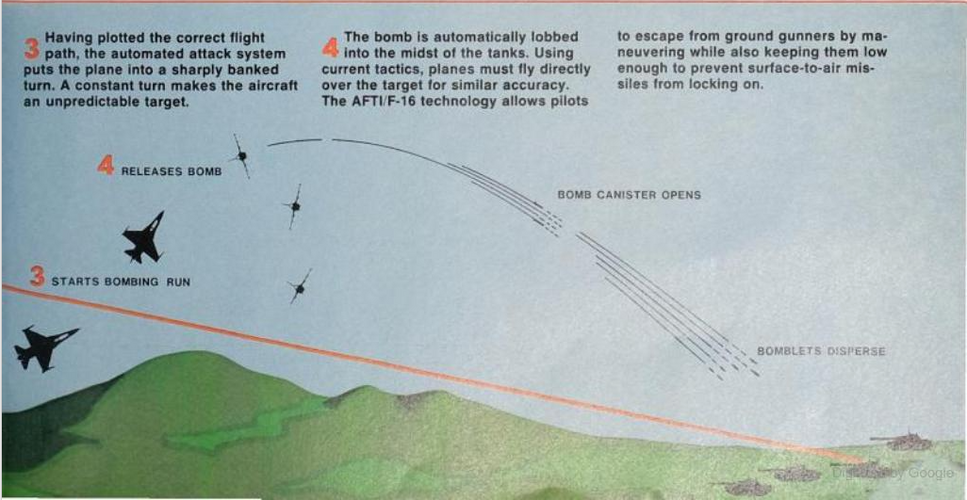You are using an out of date browser. It may not display this or other websites correctly.
You should upgrade or use an alternative browser.
You should upgrade or use an alternative browser.
Designing the replacement for the A-10
- Thread starter Scott Kenny
- Start date
-
- Tags
- a-10 a10 replacement
Scott Kenny
ACCESS: Above Top Secret
- Joined
- 15 May 2023
- Messages
- 6,253
- Reaction score
- 5,100
Turbine engines have a very narrow "power band" where they are most efficient. Different versions of the engine can have that particular band in different locations in terms of RPM.No operator/designer in their right mind will do that though.
Let's use the CFM-56 for an example. While it's said to have an F101 core, that's really just referring to the HP spool. The LP spool is completely different, and later engines even the HP spool is different.
IIRC, the CFM-56 LP spool is optimized to run at flight idle/cruise power. The F101's HP spool isn't totally happy with that, but it's not too far off the design optimization. This gives best fuel economy at flight idle and increased fuel burn per lb thrust at takeoff, as well as a reliability rate that is mindblowing for a jet engine at over 300,000 hours TBF. That's one failure after 100 overhauls. The engines basically don't come off the wing once installed at the factory unless they eat a bird (or a ground crew).
In comparison, the F101 and F110 are optimized to spend more time at 100% power or even overspeeding the HP spool at Military power (compressors do NOT like spinning over Mach 1 at the blade tips!). This actually puts their time between overhauls as something measured in cycles instead of flight hours. One cycle is flight idle to full power (or MIL/AB) and back. This also means that the F101/F110 get best fuel economy in terms of lb fuel per lb thrust at 100% instead of the flight idle HP rpm of the CFM-56. How often does an F101 or F110 come out of the aircraft?
Scott Kenny
ACCESS: Above Top Secret
- Joined
- 15 May 2023
- Messages
- 6,253
- Reaction score
- 5,100
Exactly. The F-35 and/or B-21 will do the strike and recon behind the lines.@Scott Kenny First you need to answer the question “What effect(s) are you trying to achieve?”
The A-10 was designed to autonomously find & destroy armored vehicles, close to front lines where it could be shot at by Manpads and 23mm canon. It was not designed for strike or reconnaissance behind enemy lines.
How available are those tools, compared to A10s some 25 miles (~5-6min out) behind the front lines? Also, note that my proposed bird is significantly faster than the A-10, so being 50 miles out would still mean being 5-6 minutes away.It could also be used for Close Air Support but as @red admiral says today troops on the ground (whether 1st or 2nd echelon) have many options for guided fires that can destroy a target much faster than waiting for a pair of A-10s to be vectored in.
IIRC, arty is roughly a 2-3 minute call from request to splash. That gives about 2 minutes of arty chewing on the targets before the A-10s arrive, with 1min for deconfliction clearance. Aircraft don't like being in the same airspace as 155mm fire.
Yes, that's true, though with more Loyal Wingman options I could see the A10 Replacement being the Drone Wrangler. Gonna have to be a 2 seater, though.Likewise, drones of all kinds are very able to find & destroy armored vehicles these days. And being attritable they can even do some deep reconnaissance (though jamming of comms link can be a problem).
I see the F-35 getting that role, honestly.Finally if the goal is to penetrate some distance at low altitude behind enemy lines to do armed reconnaissance, perhaps helicopters operating at night with ALE-style munitions are going to be even more successful given their ability to stop/hide.
Looks like Loyal Wingman drone wrangler directly over the front lines, with additional capacity to also strike targets there. Or vice versa, we can argue about which set of missions gets priority later.So what mission are we really talking about that can’t be done by other existing assets?
Key West requires UNARMED fixed wing aircraft for the Army. The USAF blocked the Army from flying M60-armed OV1 Mohawks.I'll just repeat it again, we have an aircraft designed specifically for this mission that can be modified or "fudged" to fit under Key West in the Scaled Composites ARES.
And all the Ares was designed to do was to see if a fully composite structure could survive the recoil of a 25mm cannon. It can. There's no tooling existing for making more, and the thing flies on a 50 year old engine design that gives it a thrust to weight ratio of less than 0.5:1 at MTOW.
If you want the Army to fly it, it needs to have about half the wingspan of the ARES, no more than 20ft. That will let it land on a road cut into a forest, or one with pasture fences on both sides, instead of needing a dedicated airfield.
And you'd still need to modify Key West to allow the Army to fly armed fixed wings, probably under 10klbs MTOW.
The OV-1 was a significantly larger aircraft over the 5,000lb ETOW limit. If you want to get around Key West the ARES is your best bet other than something like the Cheyenne. The USAF might be willing to look the other way if they can get rid of their A-10s.Key West requires UNARMED fixed wing aircraft for the Army. The USAF blocked the Army from flying M60-armed OV1 Mohawks.
And all the Ares was designed to do was to see if a fully composite structure could survive the recoil of a 25mm cannon. It can. There's no tooling existing for making more, and the thing flies on a 50 year old engine design that gives it a thrust to weight ratio of less than 0.5:1 at MTOW.
If you want the Army to fly it, it needs to have about half the wingspan of the ARES, no more than 20ft. That will let it land on a road cut into a forest, or one with pasture fences on both sides, instead of needing a dedicated airfield.
And you'd still need to modify Key West to allow the Army to fly armed fixed wings, probably under 10klbs MTOW.
I'm not suggesting a straight ARES, but rather a modern design based on it, with modern engines. You could even use the PW535A already being used by the Army U-35Bs.
Scott Kenny
ACCESS: Above Top Secret
- Joined
- 15 May 2023
- Messages
- 6,253
- Reaction score
- 5,100
You realize that the Cheyenne caused the USAF to design the A-10, right?something like the Cheyenne. The USAF might be willing to look the other way if they can get rid of their A-10s.
Chances of the USAF looking the other way is zero.
Strafing runs are obsolete except against unarmed folk . like Taliban
A10 was not survivable on day it was built and is much less so today , Today stand of weapons that keep the platform outside AD is the name of the game and for that purpose, you do not need any of the A10 survivability features. In a similar way attack helicopter is moving to pure stand-off weapons so old gunships are obsolete new unarmored but faster Raider-type choppers offer more survivable
A10 was not survivable on day it was built and is much less so today , Today stand of weapons that keep the platform outside AD is the name of the game and for that purpose, you do not need any of the A10 survivability features. In a similar way attack helicopter is moving to pure stand-off weapons so old gunships are obsolete new unarmored but faster Raider-type choppers offer more survivable
DrRansom
I really should change my personal text
- Joined
- 15 December 2012
- Messages
- 672
- Reaction score
- 198
Mr. T - the US spends most of its time fighting unarmed folk. That's the best argument for the A-10.
One observation from the Ukraine War: nobody actually has enough money for a "modern military." Not the US, not Russia, not EU, nor China. The required capabilities for the future will go down to a degree because the threat simply isn't there anymore.
One observation from the Ukraine War: nobody actually has enough money for a "modern military." Not the US, not Russia, not EU, nor China. The required capabilities for the future will go down to a degree because the threat simply isn't there anymore.
Even for action against Aks in flipflops , A10 is absolutely obsolete in . All its survivability features were meant to give it a fighting chance in AD environment. For dealing with the Aks in flipflops, you have drones, Airtractors,etc platforms that can loiter above typical threat envelope , have low cost of operation and high endurance, and massively better situational awareness than A10 can dream of and then some.And then there are Raper drones that are designed specifically to deal with poorly armed folk.Mr. T - the US spends most of its time fighting unarmed folk. That's the best argument for the A-10.
One observation from the Ukraine War: nobody actually has enough money for a "modern military." Not the US, not Russia, not EU, nor China. The required capabilities for the future will go down to a degree because the threat simply isn't there anymore.
A low cost planes with even lower operating cost , optical turrets give them unrivaled situational awareness night and day as does the second crewmembers and so far AK's flipflops never had anything this kind of plane could not deal with. A10 belongs on a bone yard and will not ever have a direct succesor.
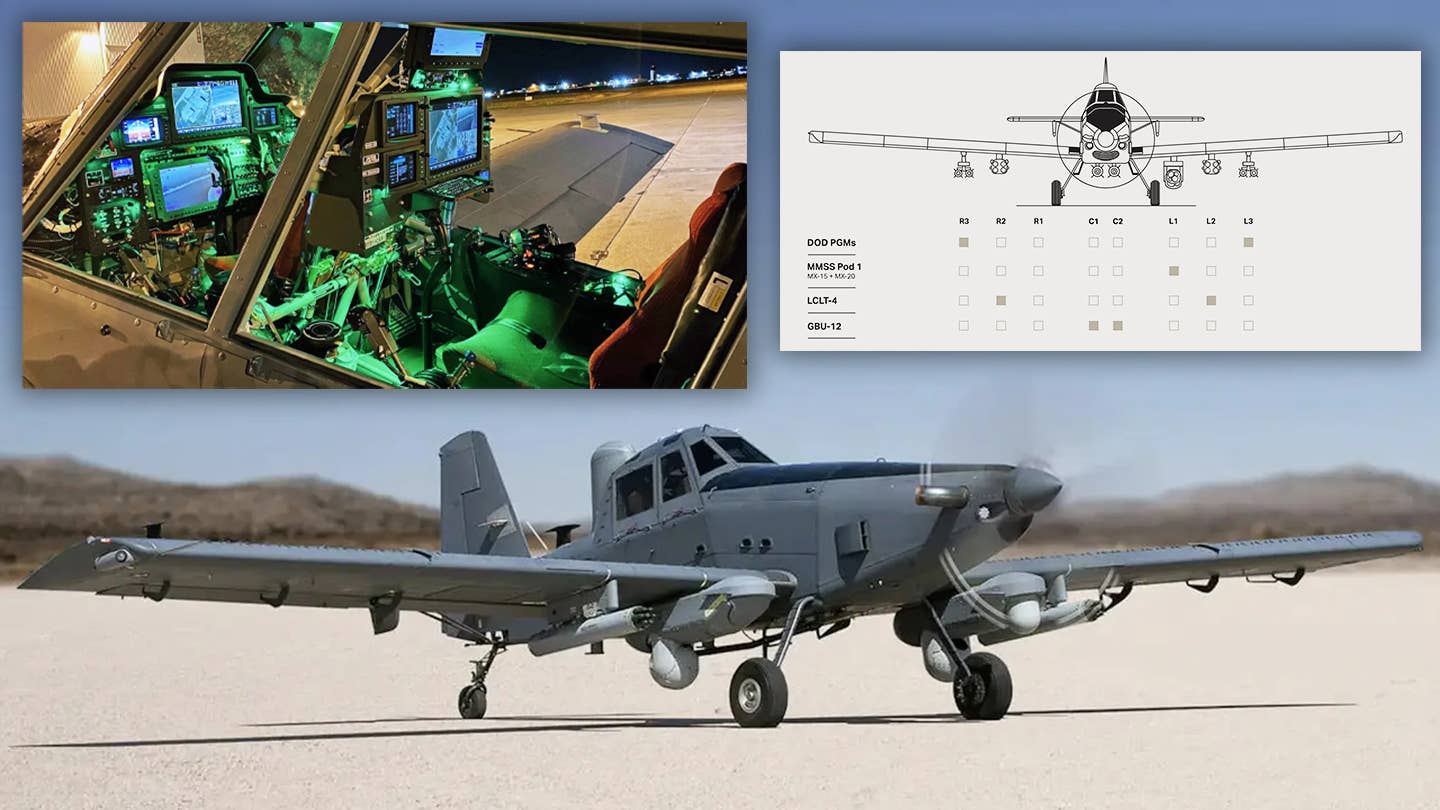
Agreed.A10 belongs on a bone yard and will not ever have a direct succesor.
Scott Kenny
ACCESS: Above Top Secret
- Joined
- 15 May 2023
- Messages
- 6,253
- Reaction score
- 5,100
Iraq wasn't exactly "unarmed" and the A-10s did pretty well there in 2003.Strafing runs are obsolete except against unarmed folk . like Taliban
A10 was not survivable on day it was built and is much less so today , Today stand of weapons that keep the platform outside AD is the name of the game and for that purpose, you do not need any of the A10 survivability features. In a similar way attack helicopter is moving to pure stand-off weapons so old gunships are obsolete new unarmored but faster Raider-type choppers offer more survivable
I will take the point about strafing runs being borderline obsolete under consideration. Part of the reason for the A-10's big gun was that the entire design team had read Rudel's book about Stukas on the Eastern Front in WW2, which fiercely advocated for strong cannon firepower. As did the A-1 Skyraider community in Vietnam.
But they didn't have precision guided bombs then, at least not that either the Stukas or the Skyraiders could use. And we have more or less everything in the inventory with a standoff Precision Guided version that we can use today.
Obviously my concept has less gun firepower than the A-10 because of the smaller gun and lack of APDS ammo like all the ground 25mm guns use. APDS ammo is a severe FOD hazard for aircraft, after all. So I don't know how well a full diameter aluminum slug with a DU core in 25x137mm would do compared to the 30x173mm.
I (obviously) respectfully disagree.A10 belongs on a bone yard and will not ever have a direct succesor.
While an Air Tractor or Predator/Reaper/Mojave drone is perfectly good for COIN missions, it's not good enough for Near-Peer engagements.
The Army still needs CAS (which is NOT just killing tanks) in Near-Peer engagements.
Remember that thread about the A-7 versus A-10? And how the two planes did two very different jobs so both were kept in the 1980s and early 1990s? The F-35 will happily do Battlefield Interdiction like the A-7 did, that's pretty much what it was designed for! Hit the bridges, resupply points, and the advancing formation's AA systems. Then you can send in an A-10 Replacement to go beat on what's left, along with attack helos and artillery.
This also gets into training. If you have a plane that can tangle with defending fighters and can hit the midfield bridges and AA systems during battlefield interdiction, that's a different skill set than what you want your CAS squadrons doing. You want your CAS pilots practicing down in the weeds using hills and valleys for cover, picking out green targets against a green background at standoff ranges, all the time.
Bruno Anthony
I miss the Cold War
- Joined
- 5 August 2012
- Messages
- 524
- Reaction score
- 431
“I think we all agree that Ukraine shows the A10 (and Su25) are nowhere near as survivable in the 2020s as they were in the 1980s and 90s.”Okay, to get this discussion out of the A-7 versus A-10 thread.
I think we all agree that Ukraine shows the A10 (and Su25) are nowhere near as survivable in the 2020s as they were in the 1980s and 90s.
Also, the USAF corporate offices hate the A-10, it's super slow both tactically and strategically, and it has several type-specific schools and pieces of equipment that come purely out of the AF budget instead of being split across the entire DOD budget. Oh, and it's supposed to directly support the Army, of all things. Eeeewwwwww.
But the mission still needs filled. And no, the F-35 can't do the dance at the FEBA. The F-35's job is to interdict the units while they're still in march order and not shook out into battle formations, the job the A-7 did in the 80s and 90s.
The major complaint A-10 pilots will give you is that it is underpowered. The total bombload an A-10 can carry weighs more than the two engines produce in thrust, nevermind the weight of the plane! This leads to A-10 pilots not on a leash like in Desert Storm going in and dumping most of their bombs in a marginally-effective way at altitude, so that they can get down low and maneuver right.
The minor complaint is the straight wing makes a painfully slow airplane when ferrying, as it runs into "coffin corner" at 20,000ft
=====
Based on all of this, the design requirements I have come up with are as follows:
(will add more requirements as suggested in the thread)
- Needs much more powerful engines, and those engines need to be ones in common use in the DOD already.
- Needs to be able to fly higher and faster.
- Uses the 25mm GAU-12 or GAU-22, which are used across the DOD and NATO and can therefore be reloaded at any base that operates F-35s.
- Other avionics also need to be used on other aircraft.
- Needs to be somewhat LO at a minimum, does not need to be absurdly LO like the B-21.
- Needs to be as resistant to battle damage as the A-10, if not more.
- Needs to be as quickly repairable as the A-10.
- Needs to have the loiter time of the A-10.
- (bonus points for figuring a way to get the Army to pay for the plane, unless we throw the Key West Agreement out entirely and let the Army fly their overhead CAS while USAF does interdiction)
=====
Now, the plane I am picturing has the following features:
Overall, picture an A10 with bigger engines, longer intakes that are blended into the airframe instead of being in separate pods, and thick leading edge swept wings. It will be a physically larger aircraft, between the 10klbs internal bays and the ~20klbs of internal fuel.
- Uses CFM-56s, which are in the DOD inventory as F108 engines. They're shared across a pretty large number of airframes, and are stupid reliable. Bonus is that the core is F101, so even more of the engine is shared across the DOD inventory. Specifically the 60" diameter fans, as used on P-8 Poseidons and C-40 Clippers. The other engine option is the RR F130 being used for the B-52 re-engining, but it's much less common than the CFM-56.
- Uses a supercritical airfoil wing, like that of the Boeing 787. This gives good lift at low speed, without stupid amounts of drag at high speed. Wing will probably be swept at about 35deg, so other edges will line up with that angle. The thick leading edge of a supercritical airfoil probably compromises radar LO a good bit, but is necessary for flight performance.
- Uses GAU-12 25mm, but with a fixed 3300rpm firing rate. The extra barrel helps to keep the gun from overheating during multiple strafing runs. Has roughly 1000rounds in the feed system. Gun is not on the centerline like the A-10, instead it's off to one side like the F-35A, F15, F16, etc. This allows the installation of an actual radar in the nose.
- Uses the full F-35 DAS EOTS system, but still has a tall bubble canopy more like the A-10 in case of DAS trouble. This encourages pilots to fly heads-up. Yes, stealthing this will be a challenge.
- Carries 10klbs or so internally, can add stuff under the wings for a total of about 25klbs (taking advantage of bigger engines and wing)
- OML is all edge-aligned and panels have LO shaping. I do NOT expect to use a lot of RAM on the airframe, that's expensive and time-consuming to repair. Another LO feature is the relocation of the IFR receptacle to the spine instead of the nose.
- Canopy is armored, cockpit has an A-10 like Titanium Bathtub but the Bathtub is sized for a two-seater by default. Fuel tanks are nitrogen purged, fuel lines have check valves to minimize leaks. Hydraulics are multiply redundant and the lines have check valves to minimize leaks.
- As many pieces as possible are symmetrical, so that they can be used on either side of the aircraft. The entire tailplane, for example. Rudders and Ailerons are symmetrical, Horizontal and Vertical Stabilizers are as well. Even the attachment points are symmetrical, and they're bolted to the end of the V-stab before being bolted to the H-stab.
- Because the engines are 3x the power of the A10, it carries more fuel. But because it mostly flies on internal weapons, it doesn't need triple the fuel capacity to equal the loiter time. I guesstimate 20klbs of fuel internally.
- I would actually toss the Key West Agreement entirely, allowing the Army to fly armed fixed wing aircraft for their CAS.
What else can you add to the list?
It’s amazing how many people think today’s weapons are head & shoulders above late Cold War weapons or those that were planned then. I think weapon development has crawled since then.
A-10s weren’t expected to last long on a Cold War battlefield by the late 80s.
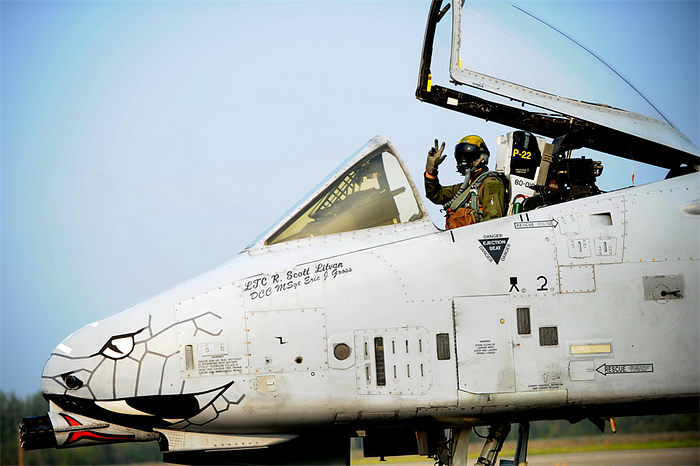
An A-10 Pilot Could Hope to Last Two Weeks Against the Soviets
Cold War planners expected to lose up to 60 A-10s a day
 medium.com
medium.com
DrRansom
I really should change my personal text
- Joined
- 15 December 2012
- Messages
- 672
- Reaction score
- 198
Strafing is one of the top capabilities of the A-10. Smallest danger-close range of any airborne weapon, because it doesn't have the 'GPS failed to lock on' failure mode.
I get the point about air-tractors, the trade-off between a turbo-prop and jet powered will be complex. I think the argument ultimately lands in favor of the A-10 because, unlike turbo-prop, an A-10 still has medium / high intensity combat utility. If employed outside major threat envelope with sufficient suppression support, A-10s could be used in Ukraine, albeit at medium risk. A turbo-prop or medium-altitude drone is useless in that environment.
I get the point about air-tractors, the trade-off between a turbo-prop and jet powered will be complex. I think the argument ultimately lands in favor of the A-10 because, unlike turbo-prop, an A-10 still has medium / high intensity combat utility. If employed outside major threat envelope with sufficient suppression support, A-10s could be used in Ukraine, albeit at medium risk. A turbo-prop or medium-altitude drone is useless in that environment.
Scott Kenny
ACCESS: Above Top Secret
- Joined
- 15 May 2023
- Messages
- 6,253
- Reaction score
- 5,100
It's less the individual weapons being better now (though they are generally better able to ignore countermeasures), but rather there being a crapton more of them. When an attack on a platoon position can result in running into 3x MAPADS launchers, that says something.“I think we all agree that Ukraine shows the A10 (and Su25) are nowhere near as survivable in the 2020s as they were in the 1980s and 90s.”
It’s amazing how many people think today’s weapons are head & shoulders above late Cold War weapons or those that were planned then. I think weapon development has crawled since then.
A-10s weren’t expected to last long on a Cold War battlefield by the late 80s.

An A-10 Pilot Could Hope to Last Two Weeks Against the Soviets
Cold War planners expected to lose up to 60 A-10s a daymedium.com
Bruno Anthony
I miss the Cold War
- Joined
- 5 August 2012
- Messages
- 524
- Reaction score
- 431
The USSR had more than what Russia has now.It's less the individual weapons being better now (though they are generally better able to ignore countermeasures), but rather there being a crapton more of them. When an attack on a platoon position can result in running into 3x MAPADS launchers, that says something.
Attachments
Like it or not big gimbaled optic turret (inherent to Reapers and Airtractor) and person operating it are magnitudes better than an A10 pilot alone with MK1 eyballs especialy if they need to stay out of MANPADS range
Yes , but both MAPADS and SAMs are much better now than in Cold War A10 is still the same. Not to mention fleets are smaller than in cold war so can take less attrition.The USSR had more than what Russia has now.
Last edited:
Scott Kenny
ACCESS: Above Top Secret
- Joined
- 15 May 2023
- Messages
- 6,253
- Reaction score
- 5,100
FM100? Yeah, each Motor Rifle company had one section of 3x Strela/Iglas in support back in the day.The USSR had more than what Russia has now.
Today it's possible to have one Igla launcher in each vehicle of a company. Not like the launchers have broken, they just make the new missile tubes talk to the old launchers.
Bruno Anthony
I miss the Cold War
- Joined
- 5 August 2012
- Messages
- 524
- Reaction score
- 431
Is that in an updated Russian TO&E or some other reference? Link?FM100? Yeah, each Motor Rifle company had one section of 3x Strela/Iglas in support back in the day.
Today it's possible to have one Igla launcher in each vehicle of a company. Not like the launchers have broken, they just make the new missile tubes talk to the old launchers.
Scott Kenny
ACCESS: Above Top Secret
- Joined
- 15 May 2023
- Messages
- 6,253
- Reaction score
- 5,100
An inference from the number of new CLUs being bought for Iglas/Igla2s/Igla3s when all the missiles are supposed to be able to talk to the same CLU.Is that in an updated Russian TO&E or some other reference? Link?
TMA1
ACCESS: Secret
- Joined
- 6 February 2021
- Messages
- 443
- Reaction score
- 617
Like it or not big gimbaled optic turret (inherent to Reapers and Airtractor) and person operating it are magnitudes better than an A10 pilot alone with MK1 eyballs especialy if they need to stay out of MANPADS range
Long range drones and tucano tier aircraft would have very slim chances of lasting long against Ukraine, let alone Russia. The reason why drones and tucano tier aircraft have been so successful in the mideast is because the enemies we faced with even a bit of air defense got their butts handed to them with our combined arms strike packages which included EW, decoys, cruise missiles, stealth bombers, etc... Only after this could the drones and slow loitering aircraft hunt without much fear.
The current conflict is extremely, extremely misunderstood I feel. For example the su-25 has proven it's worth many times over in this conflict and I know the a-10 would be just as good and in a couple areas it could do even better. Drones are not at the level yet where they can compete with a-10/su-25. The kinematics, weapons capabilities and on the fly intelligence of a seasoned pilot in the cockpit are not even close to being replicated yet.
Has the Su-25 proven its worth in this conflict? On both sides they're lofting rockets from long range like they're flying MLRS, not doing strafing runs or hunting tanks with Vikhrs. Where possible, they're using the MiG-29s to toss JDAMs or the Su-30s to loft FAB-1500s from outside SAM range.
Scott Kenny
ACCESS: Above Top Secret
- Joined
- 15 May 2023
- Messages
- 6,253
- Reaction score
- 5,100
That was the standard CONOPS of the Su25 anyways. Long range attack with rockets and LGBs. Edit: Not getting close enough to do gun runs as a regular thing.Has the Su-25 proven its worth in this conflict? On both sides they're lofting rockets from long range like they're flying MLRS, not doing strafing runs or hunting tanks with Vikhrs. Where possible, they're using the MiG-29s to toss JDAMs or the Su-30s to loft FAB-1500s from outside SAM range.
Last edited:
Colonial-Marine
UAVs are now friend, drones are the real enemy.
- Joined
- 5 October 2009
- Messages
- 1,208
- Reaction score
- 731
I don't think it was envisioned using them at such a long range where you're firing them at your general idea of where the enemy might be versus specific targets.
Kat Tsun
I really should change my personal text
- Joined
- 16 June 2013
- Messages
- 1,144
- Reaction score
- 1,276
Has the Su-25 proven its worth in this conflict? On both sides they're lofting rockets from long range like they're flying MLRS, not doing strafing runs or hunting tanks with Vikhrs.
Of course they do. It's not an A-10A. The Su-25 has actually modern ground attack capacities.
Russian pilots train to employ their helicopter/aviation rockets like MLRS using lofting trajectories. This isn't a complex calculation, it's similar to the loft bombing techniques of the 1950's, it keeps you out of range of short range AAA, and has been standard operating procedure for WP tactical aviation since the 1970's, with the appearance of the Roland missile. There are similarities with CCRP calculations in fixed-wing aircraft: you provide GPS coordinates of the target, the bombsight provides a flight path, and you follow it until the computer releases the weapons and you hit in the general area of the target.
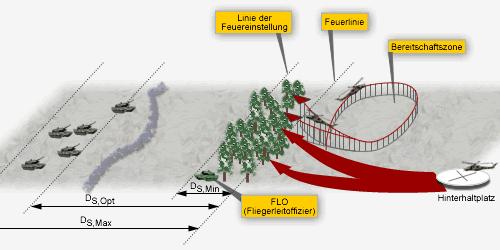
If A-10 or AH-64 can't do this, I don't know what to say, except that it's somewhat primitive?
I doubt AH-64 can't do this though, or even AH-1S or -Z, as both seem reasonably modern helicopters, and the technique would have been discovered by the Americans in Vietnam or the 1970's as a means of attacking and disrupting armor concentrations as a matter of course. It was probably one of the main methods of attack of the AH-56 and just exists, but isn't trained for, as a employment mode in the fire control computer. In that sense it's a bit like diving rocket attacks, but less dumb, since diving rocket attacks are only useful if the enemy has no functional medium to long-range SAMs.
Lobbing rockets is ultimately the only practical method of employing helicopter multiple rocket launchers in the face of high-tech air defense systems. Direct firing them gets you killed by radar guided AAA while flying high gets you swatted by radar guided missiles.
Precision guided weapons like Vikhr and Hellfire are too precious and few in number to be wasted in such jobs, when they are necessary to curtail heavy armor forces, or destroy high value objects. That America and its allies have forgotten this in their decades of romping around in the Middle East and North Africa against ostensibly mechanized forces, all of which were slightly less dangerous than plastic range targets (you still have a higher chance of dying at the US Army's Fort Irwin than in Desert Storm from enemy fire, statistically speaking), doesn't really diminish its truthfulness.
The U.S. military even has a special casette warhead for the job:
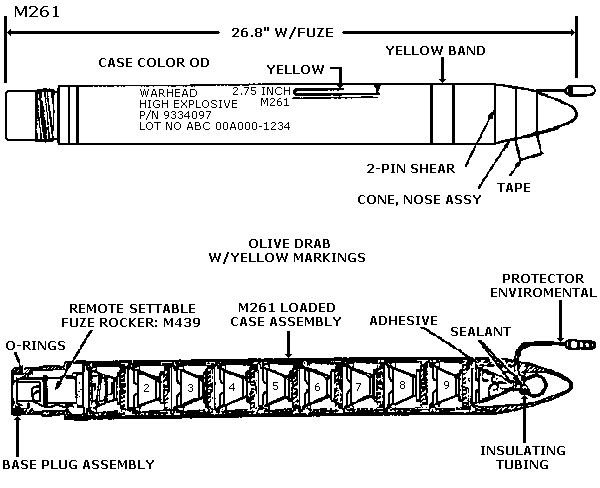
I don't think it was envisioned using them at such a long range where you're firing them at your general idea of where the enemy might be versus specific targets.
This is quite wrong. Aviation is far too complex an activity for literally every single deliberate method of use not being planned for. Both the United States and USSR planned for such methods of employment, as evidenced by development of military technics in their respective societies, but only Russia has seen the sort of wars that demand it.
Last edited:
- Joined
- 24 November 2008
- Messages
- 1,338
- Reaction score
- 1,699
Initial design requirements and 2 pages of discussion... Aircraft design is all about compromises. Stealth shaping vs aerodynamics, internal fuel vs internal weapons, etc. No room for wishful thinking. Are we gonna see a scale sketch of the aircraft you have in mind? @Scott Kenny
jsport
what do you know about surfing Major? you're from-
- Joined
- 27 July 2011
- Messages
- 6,565
- Reaction score
- 3,921
for millionth time a high flyer to replace the AC and A-10 thus focusing on a loitering gun ie ring fence the grunts from standoff w/ term loiter.
Scott Kenny
ACCESS: Above Top Secret
- Joined
- 15 May 2023
- Messages
- 6,253
- Reaction score
- 5,100
I'm a pretty terrible artist to be honest.Initial design requirements and 2 pages of discussion... Aircraft design is all about compromises. Stealth shaping vs aerodynamics, internal fuel vs internal weapons, etc. No room for wishful thinking. Are we gonna see a scale sketch of the aircraft you have in mind? @Scott Kenny
But I'll give it a try.
Scott Kenny
ACCESS: Above Top Secret
- Joined
- 15 May 2023
- Messages
- 6,253
- Reaction score
- 5,100
Not sure how stealthy that is, and side mounted ordnance like the AC-130s requires orbiting over the airspace in a pylon turn. That's a singularly vulnerable place to be.
for millionth time a high flyer to replace the AC and A-10 thus focusing on a loitering gun ie ring fence the grunts from standoff w/ term loiter.
- Joined
- 24 November 2008
- Messages
- 1,338
- Reaction score
- 1,699
I'm a pretty terrible artist to be honest.
But I'll give it a try.
This isn't a beauty contest
Start with the top view. I recommend using squared or graph paper to get the scale right.
But you should already have a rough idea of what the basic characteristics of the aircraft are. Such as the wing area required to support the weight of the aircraft. At the beginning you can use data from existing aircraft that are similar to yours.
You could also start with essential items, such as the engines, the intended IWB, etc. and then draw the aircraft around.
But never forget: it's an iterative process!
Attachments
F-2
ACCESS: Top Secret
- Joined
- 22 May 2020
- Messages
- 698
- Reaction score
- 1,220
I e been playing with this concept for a sci-fi project I’m working on. And my solution was something like the F-16 AFTI. Direct Force control and the Automatic Maneuvering attack system supposedly had a survivability ten times greater than a conventional aircraft in the ground attack role. It also had other advantages like being able to use dumb weapons with accuracy rivaling smart weapons and flat turns made staffing more accurate.

Airman
books.google.com
Attachments
greenmartian2017
The Shadow knows what lurks in the hearts of men
- Joined
- 13 May 2008
- Messages
- 163
- Reaction score
- 123
My opinion: I really like the Warthog. Beautiful plane, well designed for its role. But it is an aircraft of its time (at the time of its design), and that time is now drawing towards a close. The much-feared Fulda Gap attack by the Russians never happened, and that threat has receded into an historical footnote in Cold War history books as far as I can tell. Should we keep an A-10 manufacturing line open? I don't know.
The B-52 has to get retired too, sometime. One can talk about "infinite life" airframes....
The B-52 has to get retired too, sometime. One can talk about "infinite life" airframes....
jsport
what do you know about surfing Major? you're from-
- Joined
- 27 July 2011
- Messages
- 6,565
- Reaction score
- 3,921
when one has guided 57mm MADFIRES & LDEW and plenty of time given the high altitude ur good against approaching SAMs. Bombtrucks can standoff as arsenal planes but even Swithcblades are more expensive and vulnerable than speeding metal mass and explosive..Anything fighter is SAM meat.Not sure how stealthy that is, and side mounted ordnance like the AC-130s requires orbiting over the airspace in a pylon turn. That's a singularly vulnerable place to be.
- Joined
- 19 February 2007
- Messages
- 1,109
- Reaction score
- 1,538
Eh? That horse left the barn somewhere around 1984. The Farmingdale factory site is now a shopping mall. Hagarstown is now an undervisited museum. With the exception of the constuction of certain replacement wing componments, the Warthog has been out of production for (gulp!) almost 40 years.Should we keep an A-10 manufacturing line open?
Scott Kenny
ACCESS: Above Top Secret
- Joined
- 15 May 2023
- Messages
- 6,253
- Reaction score
- 5,100
Admittedly, I don't think that the US should have allowed that to happen, at least not until after the collapse of the Soviet Union.Eh? That horse left the barn somewhere around 1984. The Farmingdale factory site is now a shopping mall. Hagarstown is now an undervisited museum. With the exception of the constuction of certain replacement wing componments, the Warthog has been out of production for (gulp!) almost 40 years.
As long as the aircraft is still in military service, the tooling to make more should be preserved at the government's expense. We can argue about whether the physical assembly line is included in that later.
red admiral
ACCESS: Top Secret
- Joined
- 16 September 2006
- Messages
- 1,476
- Reaction score
- 1,557
Presumably only against visually laid AAA?the Automatic Maneuvering attack system supposedly had a survivability ten times greater than a conventional aircraft in the ground attack role.
jsport
what do you know about surfing Major? you're from-
- Joined
- 27 July 2011
- Messages
- 6,565
- Reaction score
- 3,921
..glad folks continue to bring up the "advantages like being able to use dumb weapons with accuracy rivaling smart weapons and flat turns made staffing more accurate." as every fighter needs to accomplish this, but if no DEAD then fighters still have issues. The capability is the finishing blow.I e been playing with this concept for a sci-fi project I’m working on. And my solution was something like the F-16 AFTI. Direct Force control and the Automatic Maneuvering attack system supposedly had a survivability ten times greater than a conventional aircraft in the ground attack role. It also had other advantages like being able to use dumb weapons with accuracy rivaling smart weapons and flat turns made staffing more accurate.

Airman
books.google.com
- Joined
- 24 November 2008
- Messages
- 1,338
- Reaction score
- 1,699
- Carries 10klbs or so internally, can add stuff under the wings for a total of about 25klbs (taking advantage of bigger engines and wing)
- Because the engines are 3x the power of the A10, it carries more fuel. But because it mostly flies on internal weapons, it doesn't need triple the fuel capacity to equal the loiter time. I guesstimate 20klbs of fuel internally.
- Uses CFM-56s, which are in the DOD inventory as F108 engines... Specifically the 60" diameter fans, as used on P-8 Poseidons and C-40 Clippers.
@Scott Kenny
Have you determined the volume required for the internal load?
What is the desired weapons mix for a typical mission?
Volume used by IWB(s), as well as internal fuel, engines and associated air intake ducting, will dictate aircraft sizing by a great extent.
In terms of what « looks right », I keep thinking of something like Boeing’s Quiet Bird (Model 853).
This had a slightly-swept wing for good all-round performance, as befits an observation plane (low 80 knot stall speed, Mach 0.7 cruise up to 50,000 feet). Lots of internal volume in the fuselage. Reasonable level of RCS reduction.
Now imagine scaling it up to fit an internal weapons bay for Hellfire / SDB sized guided ordnance (I personally would omit the gun or use an external gunpod like the F-35B’s). Also could add streamlined (low-RCS) optional wingtip rocket pods.

Maybe stretch a little to reduce drag at higher speeds (Mach 0.7-0.9) - see this nice what-if in the above thread:

Still leaves the question of engine separation and redundancy, plus optimizing for low speed loiter, so I’d be tempted to add a PT6 turboprop in the nose like on the Aarok UAV (which would allow to throttle back the jet engine at low speeds and make use of the propeller’s better efficiency):

This would produce a fast mixed-propulsion combat air support aircraft with twin engine redundancy, excellent loiter, and the ability to operate across a wide range of speeds.
A little like the early 50s Breguet Vultur, perhaps?

I don’t have the time / tools to sketch but that’s the path I would investigate…
This had a slightly-swept wing for good all-round performance, as befits an observation plane (low 80 knot stall speed, Mach 0.7 cruise up to 50,000 feet). Lots of internal volume in the fuselage. Reasonable level of RCS reduction.
Now imagine scaling it up to fit an internal weapons bay for Hellfire / SDB sized guided ordnance (I personally would omit the gun or use an external gunpod like the F-35B’s). Also could add streamlined (low-RCS) optional wingtip rocket pods.
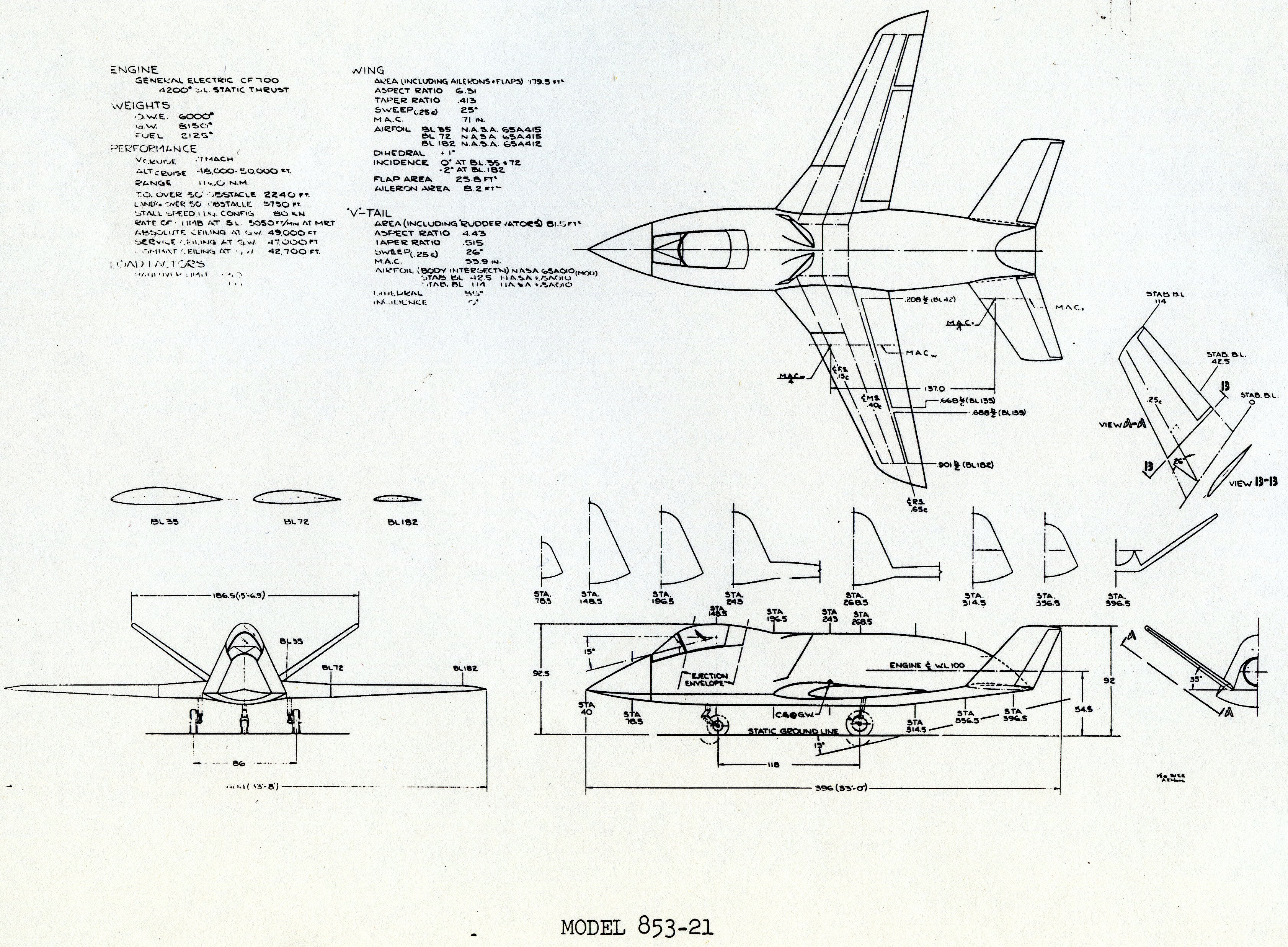
Maybe stretch a little to reduce drag at higher speeds (Mach 0.7-0.9) - see this nice what-if in the above thread:
Still leaves the question of engine separation and redundancy, plus optimizing for low speed loiter, so I’d be tempted to add a PT6 turboprop in the nose like on the Aarok UAV (which would allow to throttle back the jet engine at low speeds and make use of the propeller’s better efficiency):
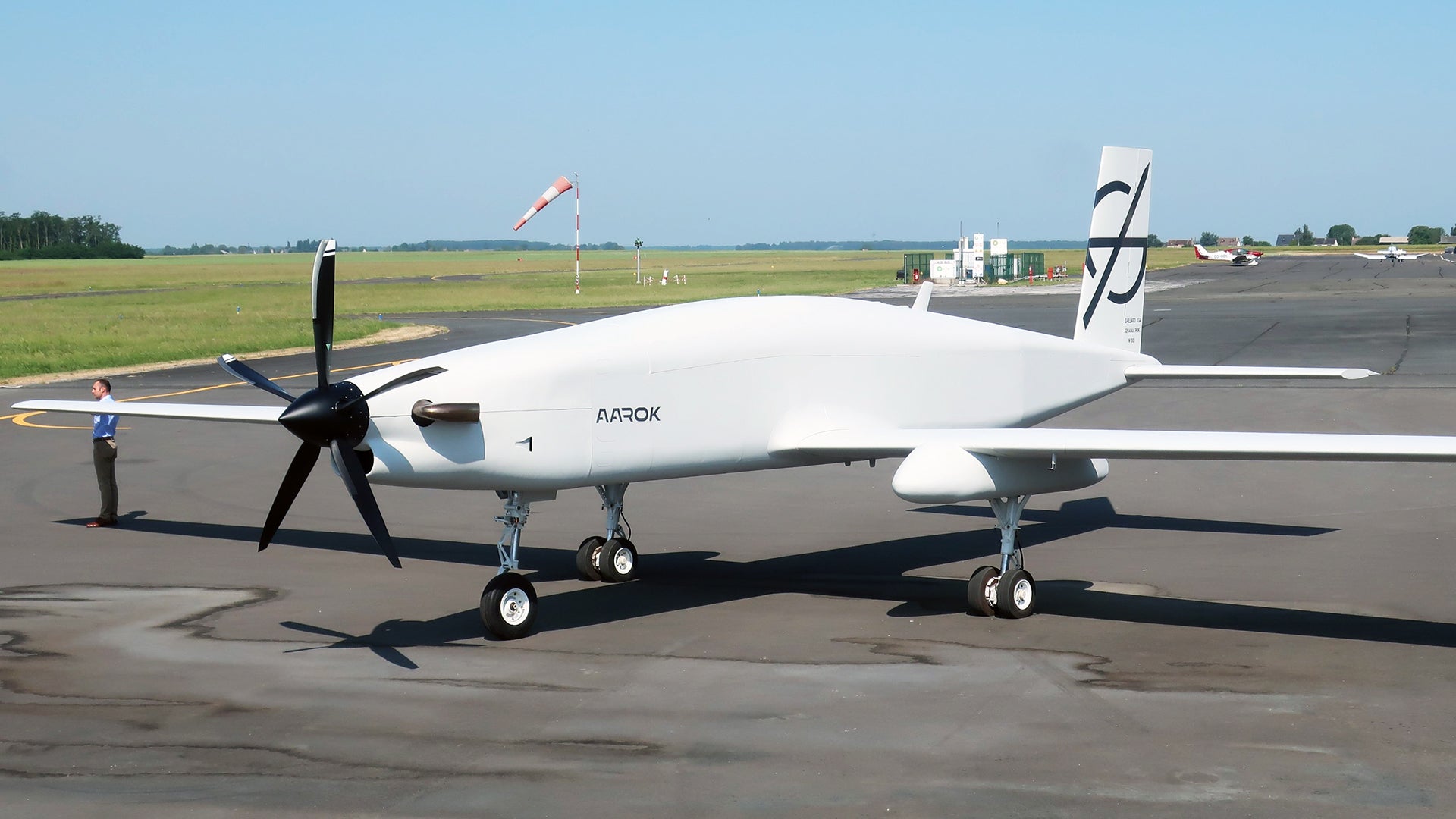
This would produce a fast mixed-propulsion combat air support aircraft with twin engine redundancy, excellent loiter, and the ability to operate across a wide range of speeds.
A little like the early 50s Breguet Vultur, perhaps?
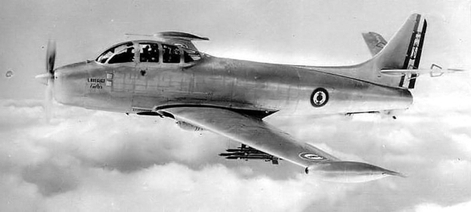
I don’t have the time / tools to sketch but that’s the path I would investigate…
Last edited:
The solution for replacing the A-10 isn't in the airframe, it's in the weapons. SDBII, APKWS, BLU-108, Hellfire R9X, and then the stuff on the drawing board...there's nothing that the A-10 does that other airframes can't replicate other than make that big buzzsaw noise and pepper a tennis court-sized area with 30mm every so often. The A-10's most impressive weapon is hype. And all its armor and redundancy isn't so it can "stay in the fight", it's so it can give its pilot extra time to get out of danger once it's hit.
I mean, I get it...I had the A-10 t-shirt when I was a kid and bought into the legend too.
I mean, I get it...I had the A-10 t-shirt when I was a kid and bought into the legend too.
Similar threads
-
-
What if we start a group design for a new fire-fighting airplane?
- Started by riggerrob
- Replies: 74
-
US Navy Multi-engine Multi-Crewed Carrier Capable Training Aircraft - T-44 Replacement
- Started by Dynoman
- Replies: 62
-
-
What if we start a group design for a next-generation trainer airplane?
- Started by riggerrob
- Replies: 6

